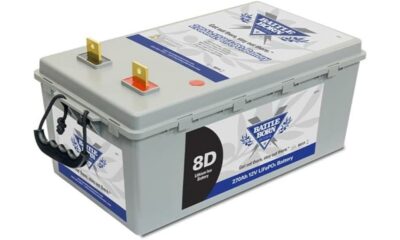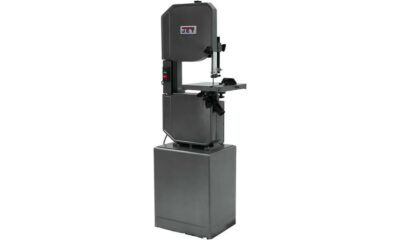Home Decor
Dresser Repurposed Into Bookshelf With 3 Easy Steps
Instantly transform an old dresser into a one-of-a-kind bookshelf with these easy, step-by-step instructions that will leave you wanting more.

You're about to give new life to an old dresser by transforming it into a functional bookshelf in just three easy steps. First, dismantle the dresser by clearing it of contents, removing drawers and hardware, and taking out center rungs. Next, assemble the bookshelf by attaching shelves to drawers and adding support with cleats or braces. Finally, add finishing touches by applying a coat of stain or paint, adding decorative trim or molding, and protecting with a polyurethane finish. With these steps, you'll be well on your way to creating a unique bookshelf that's both functional and visually appealing – and there's more to explore to bring your project to life.
Key Takeaways
• Disassemble the dresser into its individual components, including removing drawers and hardware, to create a blank canvas for repurposing.
• Attach the drawers to the shelves, adding support with cleats or braces, and ensure stability with wood screws or nails.
• Add finishing touches, such as applying a coat of stain or paint, adding decorative trim or molding, and protecting with polyurethane finish.
• Consider adjusting shelf heights, adding a personal touch with decorative elements, and matching the finishing touches to the overall design.
• Elevate the style and protection of the bookshelf by applying a protective finish, safeguarding the hard work, and achieving the desired finish.
Dismantle the Dresser
Begin by clearing the dresser of its contents, removing all drawers and hardware to create a blank slate for your repurposing project. This is the first step in transforming an old dresser into a functional bookshelf.
Take out any center rungs or dividers that may obstruct shelf placement, as you'll want a smooth surface to work with. Next, carefully disassemble the dresser, dismantling it piece by piece to prepare for repurposing. Confirm all parts are detached and ready for the next steps.
As you disassemble, imagine the possibilities – a blank canvas waiting for your creative touch. By dismantling the dresser, you're giving yourself a fresh start, a chance to reimagine and recreate something new. Take your time, and don't be afraid to get a little messy – after all, repurposing is all about giving old things new life.
With the dresser completely disassembled, you'll be ready to move on to the next step in your repurposing journey.
Assemble the Bookshelf

With your dresser completely disassembled, you're now ready to breathe new life into its components by transforming them into functional shelves. It's time to assemble the repurposed bookshelf by attaching shelves to the converted drawers. Guarantee stability and support by adding cleats or braces to hold the shelves in place.
| Step | Task | Materials |
|---|---|---|
| 1 | Attach shelves to drawers | Wood screws, cleats, or braces |
| 2 | Add support and stability | Wood screws, nails, or brackets |
| 3 | Adjust shelf heights | Measuring tape, pencil, and wood filler |
Use wood screws or nails to secure the shelves securely inside the old dresser. Measure and adjust shelf heights to accommodate different storage needs. As you assemble the bookshelf, keep in mind the overall aesthetic you want to achieve. You can also add a personal touch by painting or staining the bookshelf for a cohesive look. With these steps, you'll have a functional and stylish bookshelf made from your repurposed drawers.
Add Finishing Touches

Now that your bookshelf is assembled, it's time to add the finishing touches that will elevate its style and protection.
You've successfully transformed an old dresser into a new, repurposed bookshelf, and now it's time to make it look great. Apply a coat of stain or paint to achieve the desired finish that complements the rest of your decor.
Consider adding decorative trim or molding to give your bookshelf a polished look. If you're going for a rustic or vintage vibe, lightly distress the edges to create a unique, worn appearance.
Don't forget to safeguard your hard work with a protective finish like polyurethane to make sure your bookshelf remains durable and long-lasting.
As you add these finishing touches, make sure they match the overall design and style of your dresser-turned-bookshelf. With a little creativity and elbow grease, you'll have a one-of-a-kind piece of furniture that's both functional and beautiful.
Frequently Asked Questions
Can You Turn a Dresser Into a Bookcase?
You're wondering if it's possible to turn a dresser into a bookcase. The answer is yes, you can! By repurposing an old dresser, you can create a unique and functional bookshelf that adds character to any room.
This creative transformation allows you to upcycle old furniture, giving it a new purpose in your home. With some simple modifications, you can convert drawers into shelves, creating a one-of-a-kind bookcase that's both functional and stylish.
How to Convert Dresser Drawers to Shelves?
Are you wondering how to breathe new life into an old dresser? Converting dresser drawers to shelves can be a brilliant solution.
To start, remove the hardware and fill any holes with wood putty before sanding. Next, measure the drawer interiors to determine the ideal shelf width.
How to Make an Old Dresser Look Modern?
You're wondering how to make an old dresser look modern. Well, it's easier than you think!
Start by giving it a fresh coat of paint in a trendy color like soft blue or gray. Update the knobs or handles with modern designs to give it a contemporary look.
Additionally, consider sanding the dresser to smooth out any rough edges and create a sleek finish. With these simple updates, you'll be amazed at how modern your old dresser can look!
How to Turn a Dresser Into a Toy Box?
Imagine transforming an old dresser into a treasure trove for your little ones! To turn a dresser into a toy box, start by removing the drawers and adding a hinged lid for easy access. Don't forget to use non-toxic paint for safety.
You can customize it with chalkboard paint for labeling or fun designs. Add caster wheels for mobility and utilize drawer dividers or baskets for toy organization.
Conclusion
With your newly repurposed bookshelf, you've not only given an old dresser a second life but also debunked the myth that upcycling requires extensive craftsmanship.
In reality, a little creativity and elbow grease can transform an outdated piece of furniture into a functional and stylish bookshelf.
By dismantling, assembling, and adding finishing touches, you've successfully breathed new life into what was once destined for the landfill, proving that with minimal effort, anyone can become an upcycling pro.
Vivienne – Your Content Companion Vivienne is your content companion, curating valuable tips, advice, and inspiration to guide you on your home decor journey. From insightful blog posts to informative product descriptions, she’s here to empower you with the knowledge you need to create your dream space.
Home Decor
Embracing Sustainable Rural Design in Indonesia
Discover how Indonesia’s sustainable rural design intertwines culture and ecology, paving the way for vibrant communities—what innovative practices are emerging next?
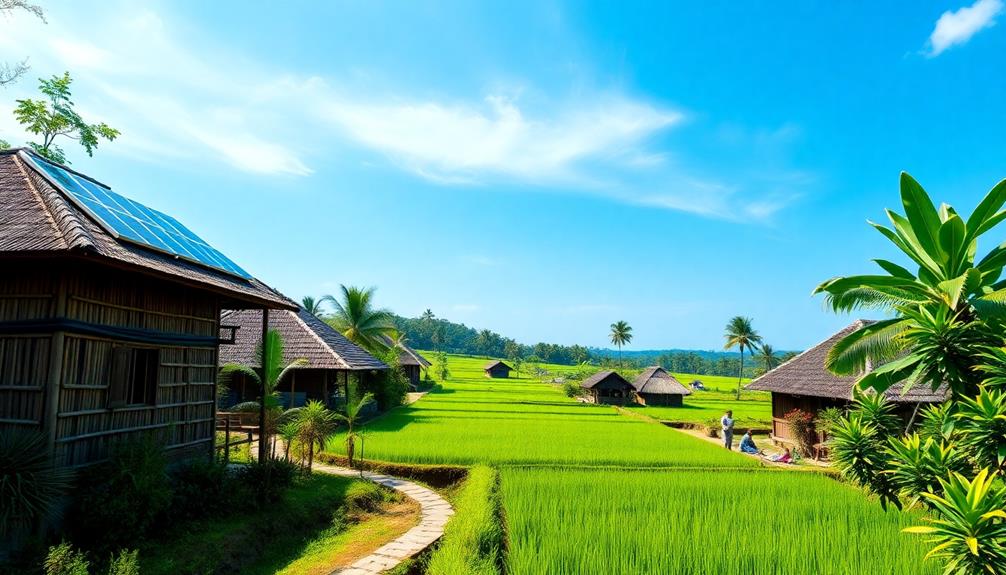
Embracing sustainable rural design in Indonesia involves blending local culture with ecological practices for vibrant communities. You'll see initiatives that prioritize community involvement and leverage Traditional Ecological Knowledge for sustainable agriculture. Local materials reflect rich traditions, while participatory design methods build resilience and social unity. Economic benefits flourish through responsible forestry and crop diversification, increasing household income and improving market access. By managing protected forests, locals enhance biodiversity and conserve essential resources. This approach not only supports environmental health but also aims for future tourism and rural empowerment. There's much more to explore about these inspiring practices and their impacts.
Key Takeaways
- Sustainable rural design in Indonesia integrates local materials and traditional housing styles to reflect cultural identity and ecological preservation.
- Community engagement is essential, allowing residents to participate in decision-making processes that shape their environment and foster social cohesion.
- Utilizing Traditional Ecological Knowledge (TEK) enhances sustainable agricultural practices, promoting biodiversity and resilience in rural communities.
- Community-based forestry management empowers households, increases income through diverse crops, and improves local water supply while conserving forest resources.
- Future goals focus on eco-tourism development and collaboration with government bodies to establish replicable models for sustainable resource management.
Overview of Sustainable Rural Design

Sustainable rural design in Indonesia plays an essential role in balancing ecological preservation with local cultural identities. This approach emphasizes community engagement, ensuring that residents actively participate in shaping their environment.
By integrating Traditional Ecological Knowledge (TEK), practices like Niteni highlight the importance of observing natural phenomena to promote sustainable agriculture, fostering both ecological balance and regional identity. Additionally, the integration of local materials in construction can reflect traditional Indonesian housing, further enriching the cultural significance of sustainable design.
Participatory design methods encourage you to become co-designers in your community, creating innovative solutions that enhance resilience and social cohesion. These methods help develop sustainable rural designs that not only protect biodiversity but also strengthen local economies.
Job creation in sectors like hospitality and agriculture results from these efforts, contributing to the local GDP while ensuring equitable access to land rights and resources.
Successful examples, such as Taba Padang village, demonstrate the effectiveness of sustainable rural design in improving livelihoods through community-based forestry management. By harnessing eco-tourism opportunities, these initiatives help protect biodiversity while simultaneously enhancing the quality of life for residents.
Ultimately, embracing sustainable rural design means investing in a future where ecological preservation and cultural heritage thrive together.
Community-Based Forestry Management

In the heart of Taba Padang village, community-based forestry management has transformed the way residents interact with their environment. This initiative allows 470 households to manage 1.5 hectares of protected forest each, promoting sustainable agriculture and biodiversity conservation.
With an emphasis on integrating traditional practices, local artisans also contribute by creating Indonesian decorative pillows that reflect cultural heritage, adding a touch of vibrancy to the community's living spaces. Spearheaded by village chief Yoyon, it took nearly four years to secure permits, prohibiting land clearing for plantations while allowing crops to thrive in the understory.
Since implementing this model, farmers have reported significant income increases through the cultivation of coffee, pepper, durian, and rattan. Additionally, they've enjoyed improved water supply from forest farms, which is essential for rural development.
Regular inspections by officials every five years guarantee adherence to conservation practices, reflecting the community's commitment to forest protection and sustainable land use.
Taba Padang's success has garnered recognition from the Indonesian Ministry of Environment and Forestry, showcasing a balanced approach to economic growth and environmental conservation.
Economic and Social Benefits
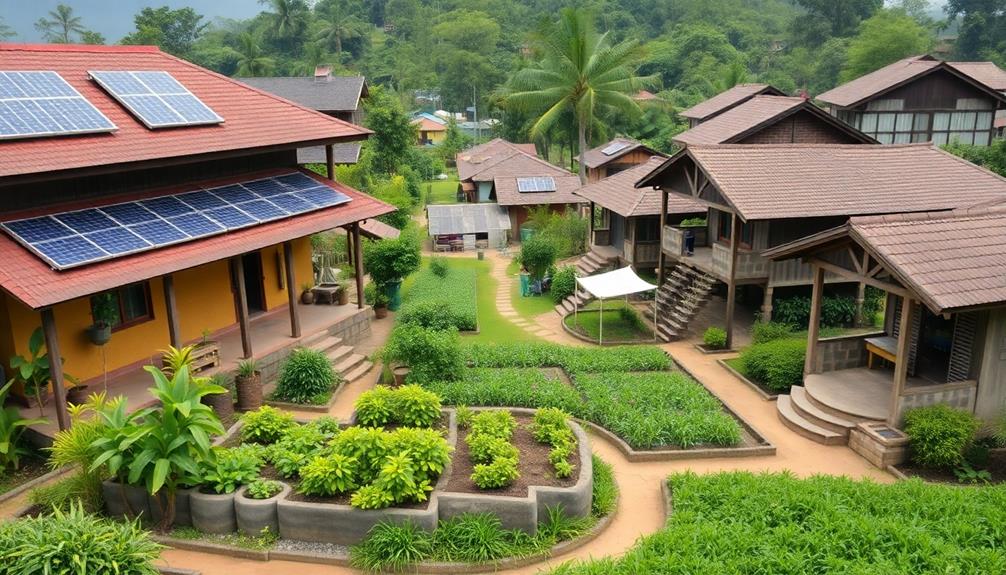
The implementation of community-based forestry management in Taba Padang village has brought tangible economic and social benefits to its residents. By focusing on sustainable farming practices, 470 households have experienced significant income increases through the cultivation of coffee, pepper, durian, and rattan. This economic upliftment has been further enhanced by improved transportation, as motorbikes now enable farmers to efficiently transport their harvests to markets.
Furthermore, the use of local materials in housing can potentially complement these agricultural practices, creating a holistic approach to rural development.
Additionally, the effective management of forest resources has led to an improved water supply, which has positively impacted agricultural productivity and the overall quality of life within the community. The recognition from the Indonesian Ministry of Environment and Forestry not only validates these local efforts but also opens doors for eco-tourism, presenting new opportunities for rural development.
As community members engage in sustainable practices, they feel more empowered, reducing anxiety over legal repercussions related to farming in protected areas. This shift fosters a sense of local governance, allowing residents to take charge of their resources and future.
Essentially, the economic and social benefits of community-based forestry in Taba Padang create a more resilient and thriving community.
Environmental Conservation Strategies

Shifting from deforestation to a focus on reforestation and conservation has transformed Taba Padang village into a model of environmental stewardship. By recognizing forest conservation as crucial for community livelihoods, you can see how sustainable practices thrive here. With each household managing 1.5 hectares in a protected forest, land clearing for plantations is prohibited, allowing for the cultivation of diversified crops in the understory, which helps maintain ecological balance.
Here's a snapshot of the environmental conservation strategies being employed:
| Strategy | Description |
|---|---|
| Protected Forest | 9.95 square kilometers managed by local farmers |
| Crop Diversification | Coffee, pepper, durian, and rattan cultivated |
| Regular Inspections | Conducted every five years for compliance |
| Biodiversity Promotion | Conservation of rare species like Hornstedtia rubra |
| Community Engagement | Fostering involvement in wildlife protection |
These initiatives not only enhance biodiversity but also play a significant role in rural development. The village's commitment to environmental conservation shows that preserving nature can lead to thriving community livelihoods and a sustainable future.
Future Aspirations and Goals
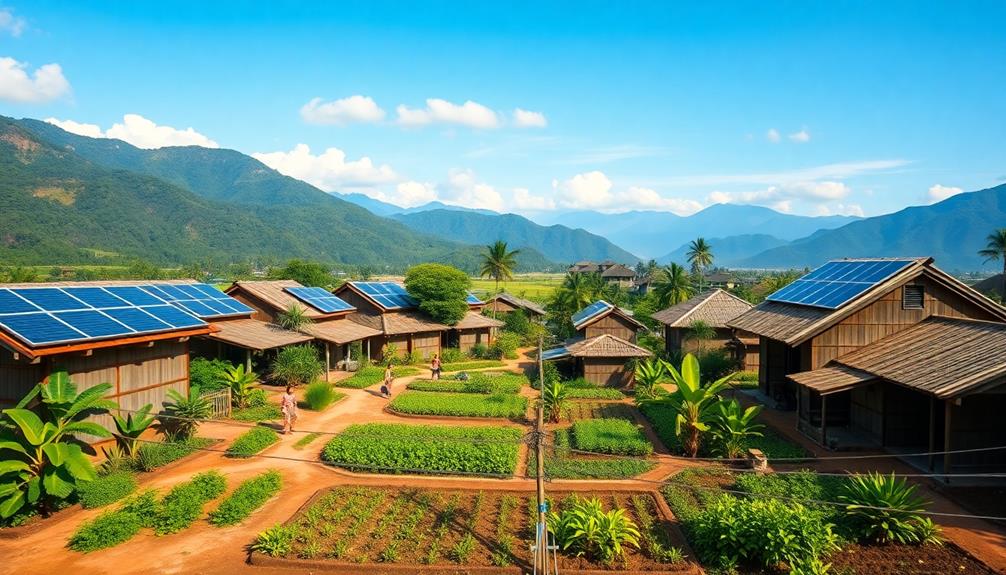
As Taba Padang village looks to the future, it's determined to enhance local welfare while preserving its precious forest resources. The community's commitment to sustainable development is evident as they actively engage in conservation efforts, ensuring the sustainable management of their forested areas.
By prioritizing forest conservation, you're not just protecting the environment; you're improving the quality of life for everyone in the village. This commitment aligns with principles found in tropical architecture, which emphasizes harmony with the natural surroundings.
Local tourism is a key focus, with aspirations to attract visitors to natural attractions like waterfalls and hot springs. This approach can boost the village's economy and create job opportunities, benefiting local communities.
You'll see that the integration of community-based forestry management is essential, as it empowers residents to take charge of their natural resources. Collaborating with government bodies will also play a significant role in refining these sustainable practices.
Taba Padang aims to serve as a replicable model for other Indonesian villages, demonstrating effective natural resource management and sustainable development. By embracing these goals, you're not just enhancing local welfare today; you're ensuring a sustainable and prosperous future for generations to come.
Frequently Asked Questions
What Sustainability Strategies Have Been Implemented in Indonesia?
In Indonesia, you'll find strategies like community-managed forests, diverse crop cultivation, and regular inspections promoting sustainable practices. By integrating Traditional Ecological Knowledge, locals engage in participatory designs, enhancing resilience and sustainable development in their communities.
What Is the Indonesia Sustainable Landscapes Management Program?
The Indonesia Sustainable Landscapes Management Program focuses on improving livelihoods through sustainable forest management. You'll engage with communities, governments, and the private sector to address deforestation, enhance food security, and guarantee equitable land access.
How Can We Make Sustainable Rural Communities?
You know the saying, "Many hands make light work." To create sustainable rural communities, engage locals in decision-making, utilize traditional knowledge, diversify economies, and foster collaboration, ensuring everyone's voice contributes to a thriving, resilient future.
Why Is Sustainability Important in the Rural Areas?
Sustainability's essential in rural areas because it preserves biodiversity, enhances local livelihoods, and strengthens community ties. By adopting sustainable practices, you're not only protecting the environment but also fostering economic resilience and social cohesion for future generations.
Conclusion
In embracing sustainable rural design, you're not just enhancing the environment; you're fostering vibrant communities. Did you know that Indonesia's community-based forestry management has led to a 30% increase in local incomes? By prioritizing eco-friendly practices, you're contributing to a healthier planet and empowering local economies. As you look to the future, keep pushing for innovative strategies that balance economic growth with environmental stewardship. Together, you can make a lasting difference for generations to come.
Home Decor
Top Sustainable Rural Design Trends in Indonesia
Keen to discover how Indonesia blends tradition with innovation in rural design? Uncover the trends reshaping sustainable living and community resilience.
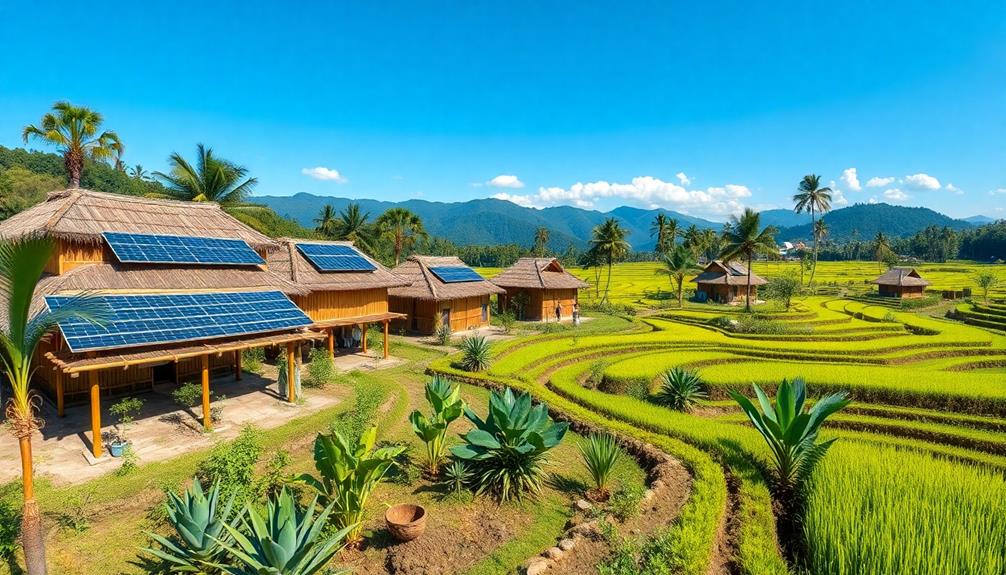
Top sustainable rural design trends in Indonesia focus on preserving cultural heritage while promoting ecological integrity. You'll see participatory design approaches that engage locals, ensuring their voices shape development. Traditional Ecological Knowledge, like Niteni and Pranatamangsa, enhances agricultural practices and fosters community ties. Community engagement strategies empower local craftsmanship and strengthen identities. Additionally, the Smart Villages concept utilizes technology to improve living conditions and promote entrepreneurship. These trends not only enhance resilience but also connect people to nature. If you're curious about how these elements come together for a sustainable future, there's much more to explore.
Key Takeaways
- Participatory design approaches empower communities by involving locals in the design process, ensuring their needs and cultural identities are prioritized.
- Traditional Ecological Knowledge (TEK) supports sustainable agriculture, utilizing techniques like Niteni and Pranatamangsa to enhance crop yields and biodiversity.
- Community engagement strategies promote local craftsmanship and traditions, strengthening community identity and fostering pride in cultural heritage.
- The Smart Villages concept utilizes ICT to enhance living conditions, promote local entrepreneurship, and support environmental stewardship in rural areas.
- Future directions focus on integrating TEK with luxury tropical design aesthetics, maintaining a connection to nature while promoting sustainable practices.
Impact of Industrialization on Rural Areas
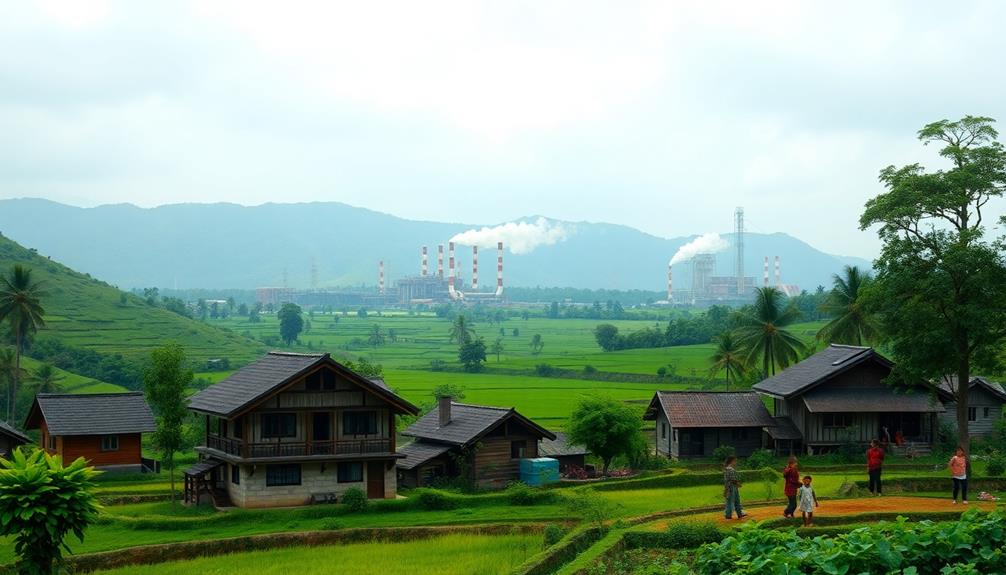
Industrialization in Indonesia has profoundly impacted rural areas, reshaping lives and landscapes alike. As you observe the shift from traditional farming to modern agricultural practices, you'll notice the erosion of cultural identities tied to these age-old methods.
The Green Revolution of 1968 marked a turning point, prioritizing economic growth over sustainable development, leading to significant environmental degradation and a loss of biodiversity. This transformation has also influenced traditional housing designs, as many rural communities are adapting to modern materials and construction methods, often at the expense of their cultural heritage and sustainability principles.
Traditional Indonesian houses typically utilize natural materials that promote sustainability, a practice that's increasingly overlooked in favor of contemporary building techniques.
Urbanization policies have exacerbated the economic divide, leaving rural poverty rates at 12.36% as of September 2022. This uneven development has disrupted not only local economies but also the community ties that once flourished around farming.
Mechanized practices have taken precedence, focusing on profit rather than ecological sustainability, which further contributes to the decline of traditional farming.
As you witness these changes, it becomes clear that the need for sustainable rural development in Indonesia is critical. By integrating traditional ecological knowledge into modern practices, you can help revitalize rural communities and preserve their cultural heritage amidst the pressures of industrialization.
Embracing sustainable design practices can pave the way for a more balanced approach that honors both economic growth and the environment.
Participatory Design Approaches
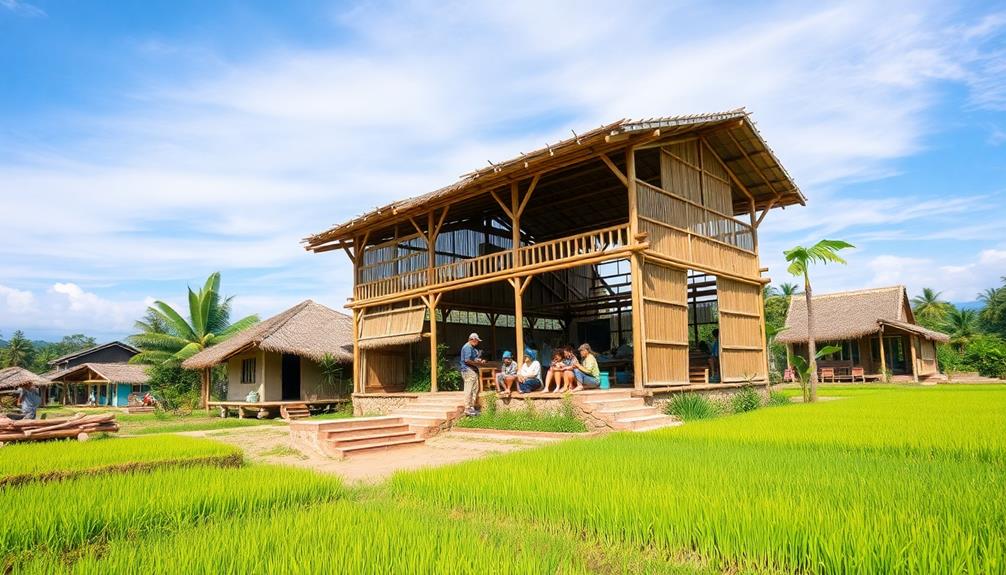
As rural communities in Indonesia face the challenges of modernization, participatory design approaches offer a solution that empowers locals by involving them directly in the design process. By treating community members as active contributors rather than passive subjects, you enhance local ownership and guarantee that projects are relevant to their needs.
This is particularly important in regions where traditional housing styles, such as Rumah Adat, reflect cultural significance and social status, emphasizing the need for designs that resonate with local identities.
The participatory design process includes activities like initiation meetings, treasure mapping, and idea generation workshops. These methods help identify community assets and guarantee all voices are heard. Engaging diverse stakeholders—such as local farmers and government representatives—fosters collaborative engagement to tackle local development challenges and promotes resilience in rural communities.
Additionally, utilizing ethnographic methods allows you to document local cultural practices, guaranteeing designs are informed by the unique context of the area. This approach supports sustainable development by integrating Traditional Ecological Knowledge, which enhances agricultural practices and strengthens regional identity.
Ultimately, participatory design not only addresses immediate needs but also nurtures a sense of community empowerment, setting a foundation for long-term ecological balance and sustainable growth in rural Indonesia.
Traditional Ecological Knowledge

In Indonesia, you'll find that Traditional Ecological Knowledge (TEK) plays a crucial role in sustainable agriculture through techniques like Niteni, which encourages careful observation of nature.
This approach aligns well with the use of natural materials in various aspects of Indonesian life, such as in Indonesian Kitchen Decor, where bamboo and wood enhance functionality and beauty.
By following the Pranatamangsa seasonal guidelines, farmers can align their practices with natural cycles, ensuring healthier crops.
Embracing TEK not only promotes environmental balance but also strengthens community ties and regional identity.
Niteni Observation Techniques
While many modern agricultural techniques focus on technology, Niteni observation techniques rooted in traditional ecological knowledge offer invaluable insights for sustainable farming in Indonesia. By engaging in Niteni, you can closely observe and document natural phenomena, allowing you to understand seasonal changes and ecological patterns that influence your farming practices.
This approach is essential for making informed decisions about when to plant and harvest, as guided by the Pranatamangsa calendar. Additionally, integrating elements of local culture, such as unique artistic expressions reflected in traditional crafts, can enhance community engagement and pride.
Niteni emphasizes the interconnection between human activities and nature, promoting sustainable living and ecological balance in rural areas in Indonesia. As you incorporate Niteni into your agricultural practices, you not only enhance your regional identity and local pride but also foster community engagement and empowerment.
This participatory design process supports the preservation of cultural heritage and biodiversity, key factors for sustainable development.
Utilizing Niteni in your farming methods can create a more resilient agricultural system that respects local traditions while adapting to modern challenges. By embracing these traditional observation techniques, you contribute to a sustainable future that honors both your community and the environment.
Pranatamangsa Seasonal Guidelines
Building on the insights gained from Niteni observation techniques, the Pranatamangsa seasonal guidelines offer a structured approach to agricultural timing in Indonesia. This traditional ecological knowledge system helps you optimize your agricultural activities by aligning planting and harvesting times with natural indicators.
By observing local weather patterns, moon phases, and ecological changes, you can enhance crop yields and better manage your resources. This approach resonates with the principles of Balinese design characteristics, which emphasize sustainability and a connection to nature.
Incorporating Pranatamangsa into your farming practices not only supports sustainable development but also reinforces the cultural identity of rural Indonesia. This deep-rooted wisdom enables you to mitigate the risks of crop failure, promoting food security and environmental stewardship within your community.
As you embrace these seasonal guidelines, you contribute to the preservation of local ecosystems and biodiversity. Utilizing Pranatamangsa reflects the importance of traditional design in modern agriculture, reminding you that sustainable practices are rooted in respecting nature.
Community Engagement Strategies

When you engage with rural communities in Indonesia, using collaborative design approaches can notably enhance the outcome.
By integrating local knowledge, such as traditional craftsmanship and cultural symbols, you not only respect their traditions but also empower them to participate actively in the design process.
This aligns with the principles of Indonesian wedding decor ideas, fostering sustainable practices that resonate with the community's values and needs.
Collaborative Design Approaches
Engaging communities in the design process is essential for fostering sustainable rural development in Indonesia. By utilizing collaborative design approaches, you can guarantee that all community members participate in decision-making, leading to impactful social innovation. Participatory learning techniques, like initiation meetings and craft design workshops, actively involve stakeholders, making them co-creators of their environment.
Incorporating Traditional Ecological Knowledge (TEK) enriches the design by preserving local narratives and identities. Recently, a project included 58 participants—24 from the local community and 28 from outside—highlighting the significance of diverse stakeholder collaboration for effective rural development.
Here's a quick look at key aspects of collaborative design approaches:
| Aspect | Description |
|---|---|
| Participatory Learning | Engaging community in decision-making processes |
| Multi-Sector Collaboration | Involving diverse stakeholders for effective solutions |
| Social Innovation | Creating sustainable and innovative community-led projects |
Focusing on openness and connectedness encourages knowledge exchange, addressing local challenges through a holistic approach. By embracing these strategies, you're not just designing spaces; you're empowering communities to shape their futures sustainably.
Local Knowledge Integration
Integrating local knowledge into the design process greatly enhances community engagement strategies in rural Indonesia. By utilizing local knowledge integration, you tap into the rich resources of Traditional Ecological Knowledge (TEK), which fosters sustainable development. Engaging local stakeholders through participatory design allows you to create solutions that resonate with community values and needs.
Additionally, incorporating elements such as traditional artistry into your designs can further enrich the cultural significance of the projects.
In your approach, consider using ethnographic methods to document community life. This helps capture local perspectives that inform your design decisions, reinforcing cultural narratives and ensuring that your initiatives reflect the community's identity.
Activities like treasure mapping and craft design workshops encourage community empowerment, giving locals a sense of ownership over development projects.
Collaborative engagement with diverse stakeholders, including local farmers and government representatives, is essential for addressing local development challenges. By actively involving these groups in the design process, you promote social innovation that benefits everyone.
Case Study: Sabrang Village

Sabrang Village, nestled in Delanggu District, serves as a compelling example of sustainable rural design in Indonesia. This village is renowned for its rice production, yielding around 20,395 tons annually, thanks to the cultivation of local varieties like Rojolele and Mentik Wangi.
The community's commitment to sustainable development is evident through its participatory design practices, which engage 58 participants, including local farmers and external stakeholders. This collaboration fosters community involvement, ensuring that everyone has a voice in shaping their environment.
Moreover, the use of traditional Indonesian style home decor within village structures enhances the cultural significance and aesthetic appeal of the community.
Traditional Ecological Knowledge (TEK) plays an essential role in Sabrang's agricultural practices. Techniques like Niteni and Pranatamangsa guide farmers in observing natural phenomena and adhering to seasonal farming guidelines.
The village emphasizes traditional design that reflects local cultural values and craftsmanship, inspired by Japanese design traditions. This approach not only enhances identity-making but also strengthens community-building efforts.
Sabrang's focus on co-creation and participatory learning is key to enhancing the resilience of its agricultural practices and overall community life. By integrating these elements, Sabrang Village exemplifies how sustainable rural design can effectively harmonize cultural heritage with modern agricultural needs.
Smart Villages Concept
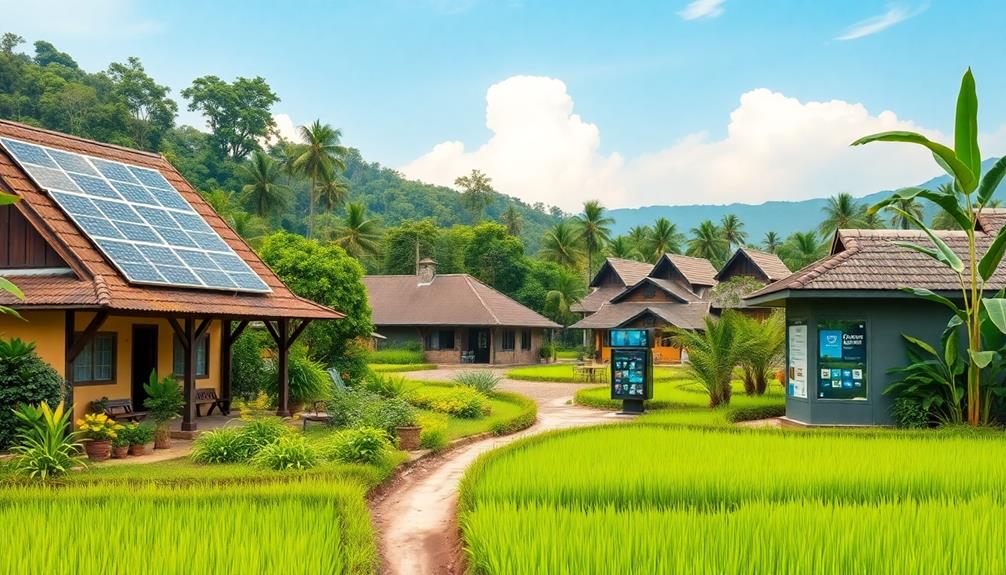
How can the Smart Villages concept transform rural life in Indonesia? By leveraging information and communication technology (ICT), Smart Villages enhance community resilience and promote sustainable development. This approach addresses vulnerabilities and improves local living conditions, fostering social inclusion and collective well-being.
| Key Elements | Benefits | Examples |
|---|---|---|
| ICT Integration | Improved access to services | Pondok Ranji for education |
| Local Entrepreneurship | Economic growth | Geluran Taman for language skills |
| Community Collaboration | Tailored solutions | Stakeholder engagement |
| Sustainable Practices | Environmental stewardship | Renewable energy initiatives |
The COVID-19 pandemic highlighted the need for Smart Villages, emphasizing their role in sustainable national development. As of 2022, 8.43% of villages were classified as Independent, while 27.34% were Developed, illustrating ongoing efforts to bridge rural disparities. Successful implementations demonstrate innovative strategies that attract investment and empower local entrepreneurs. By prioritizing community characteristics and input, Smart Villages can effectively meet local needs, fostering a resilient and inclusive rural environment. This transformation not only enhances living conditions but also paves the way for a brighter future for rural Indonesia.
Future Directions in Rural Design
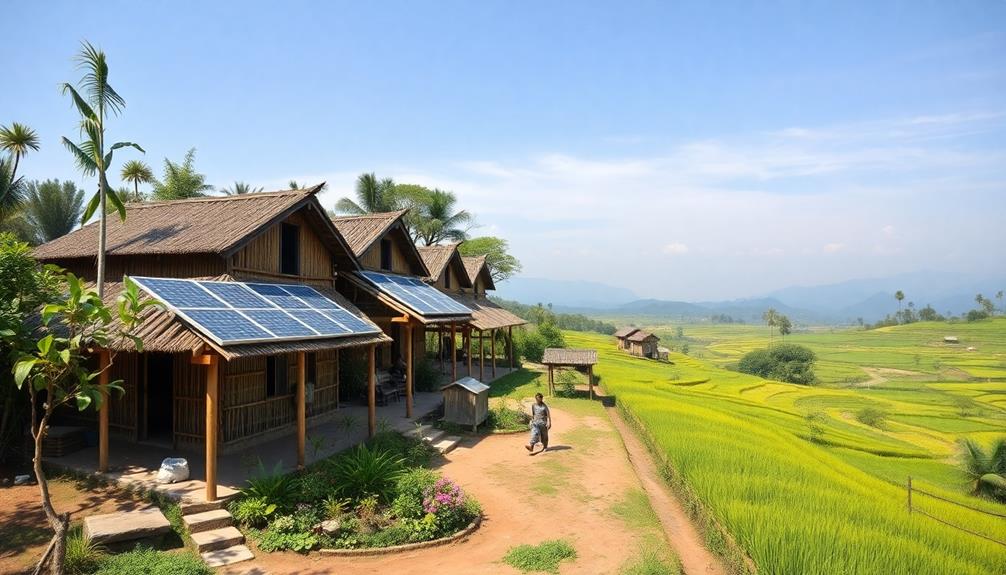
Embracing innovative approaches, future rural design in Indonesia is set to harness Traditional Ecological Knowledge (TEK) and smart village concepts to create sustainable environments.
By integrating TEK, you'll promote sustainable agricultural practices and enhance local biodiversity, drawing inspiration from methods like Niteni and Pranatamangsa, which emphasize observing nature. Additionally, incorporating elements from luxury tropical design aesthetics can enhance the visual appeal of rural spaces while maintaining a connection to the natural environment.
As you engage in community-focused design, participatory approaches will allow you to shape social landscapes, fostering a strong local identity and empowering residents. By prioritizing the community's input, you'll create spaces that resonate with their values and needs.
Moreover, the shift toward smart villages will leverage technology, enhancing local economies and resilience. With robust information and communication technology (ICT) infrastructure, rural areas can access improved education, health services, and economic opportunities.
This digital transformation addresses vulnerabilities highlighted during the COVID-19 pandemic, ensuring no community is left behind.
Lastly, incorporating biophilic principles in design will strengthen the connection between people and nature, enhancing mental well-being and promoting ecological stewardship.
Future rural design in Indonesia is poised to create vibrant, sustainable communities that thrive through innovation and collaboration.
Frequently Asked Questions
What Are the Benefits of Using Locally Sourced Materials in Rural Design?
Using locally sourced materials in rural design enhances sustainability, reduces transportation costs, and supports the local economy. You'll also create a unique character in your projects while minimizing environmental impact and fostering community pride.
How Does Permaculture Contribute to Food Security in Rural Indonesia?
Permaculture boosts food security by creating diverse, resilient ecosystems. You'll see improved soil health, increased crop yields, and reduced reliance on external resources. It empowers communities to sustainably manage resources and adapt to changing environmental conditions.
What Renewable Energy Options Are Popular in Indonesian Rural Areas?
Imagine the sun rising over lush fields, symbolizing hope. In Indonesian rural areas, solar panels and micro-hydropower systems thrive, providing clean energy. You'll find communities harnessing wind power too, embracing sustainable solutions for a brighter future.
How Can Water Conservation Techniques Be Implemented in Rural Designs?
To implement water conservation techniques in rural designs, you can integrate rainwater harvesting systems, use permeable materials for landscaping, and install efficient irrigation methods. These strategies will help you optimize water use and promote sustainability.
What Role Does Cultural Heritage Play in Sustainable Rural Design Trends?
Cultural heritage, akin to a well-worn path, shapes sustainable rural design by infusing local narratives, traditions, and materials. You'll find that respecting these elements fosters community identity and guarantees environmental harmony for future generations.
Conclusion
As you explore the top sustainable rural design trends in Indonesia, you'll see a striking contrast: the pull of industrialization versus the resilience of traditional practices. By embracing participatory design, integrating ecological wisdom, and fostering community engagement, you can help shape vibrant, sustainable futures for rural areas. The journey from Sabrang Village to the smart villages concept illustrates that innovation doesn't have to compromise heritage. Instead, it can harmonize with it, creating a richer, more sustainable landscape for all.
Home Decor
What Are Indonesia’s Sustainable Rural Design Trends?
What are Indonesia’s sustainable rural design trends that integrate traditional knowledge and modern practices, and how do they shape the future of local communities?
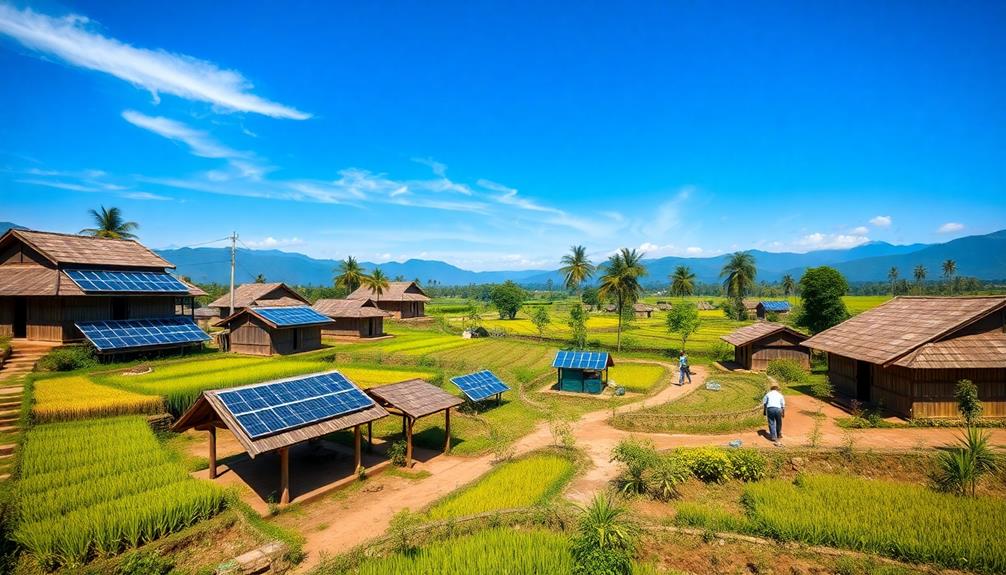
Indonesia's sustainable rural design trends focus on integrating Traditional Ecological Knowledge (TEK) with modern approaches to enhance community resilience. You'll see participatory design methods empowering locals as co-designers, ensuring that their unique needs are met. Initiatives like the Taba Padang village's forest scheme promote sustainable farming while preserving biodiversity. Engagement strategies emphasize collaboration, fostering social innovation and ownership. These trends not only enrich local identity but also improve economic prospects through sustainable practices, like cultivating traditional crops. There's so much more to explore about Indonesia's journey toward sustainability, and these trends are just the beginning.
Key Takeaways
- Integration of Traditional Ecological Knowledge (TEK) enhances sustainable farming practices and aligns agriculture with ecological cycles in rural communities.
- Community-driven initiatives, such as village forest schemes, promote biodiversity and prevent deforestation while improving crop yields.
- Participatory design empowers local residents to co-create sustainable solutions, fostering community engagement and ownership in development projects.
- Ethnographic methods document local cultural practices, ensuring that design outcomes reflect unique community identities and needs.
- Increased market access through improved transportation, like motorbikes, supports economic development and sustainable livelihoods for rural farmers.
Impact of Industrialization and Urbanization
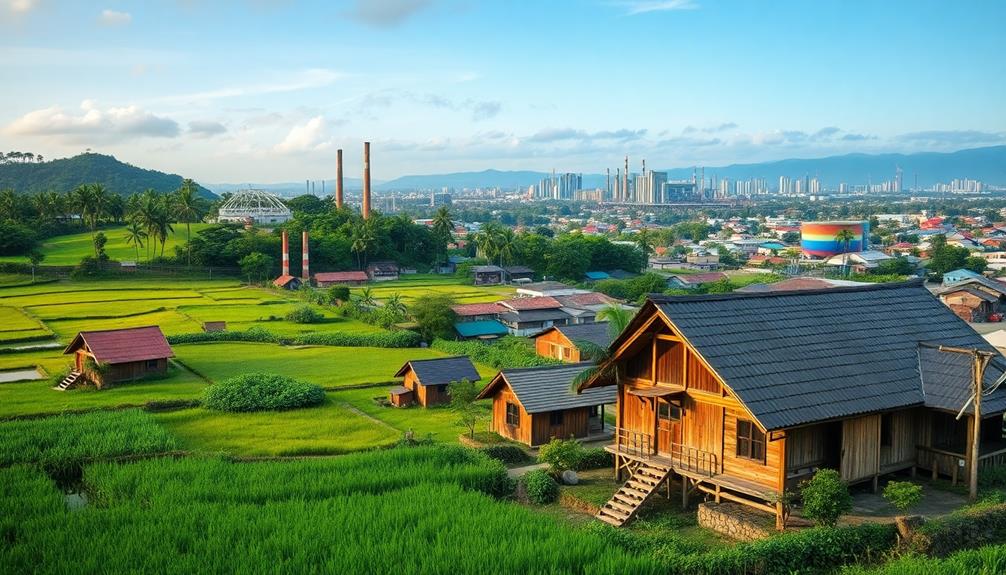
The rapid industrialization and urbanization in Indonesia have profoundly reshaped rural communities and their traditional farming practices. Since the Green Revolution in 1968, mechanized farming techniques have taken root, greatly reducing biodiversity in rural areas.
You may find that the vibrant cultural expressions, such as the Indonesian Decor Mask, are increasingly at risk as these changes take hold. You've likely noticed how urbanization policies have deepened the economic divide, exploiting rural resources and pushing poverty levels higher—12.36% of the rural population faced this challenge as of September 2022.
This shift towards profit-driven, efficient farming hasn't only led to ecological degradation but also eroded cultural practices central to these communities' identities.
As you observe these changes, it's clear that sustainable development is essential for the future of rural Indonesia. Integrating Traditional Ecological Knowledge (TEK) into modern agricultural practices can foster resilience in these communities.
TEK embodies local wisdom and ecological balance, offering invaluable insights that modern methods often overlook. By embracing sustainable design practices that honor these traditions, you can help mitigate the vulnerabilities faced by rural areas, ensuring that their unique cultural heritage and ecological health are preserved.
This approach not only benefits the environment but also strengthens community ties and identity.
Participatory Design and Co-Creation
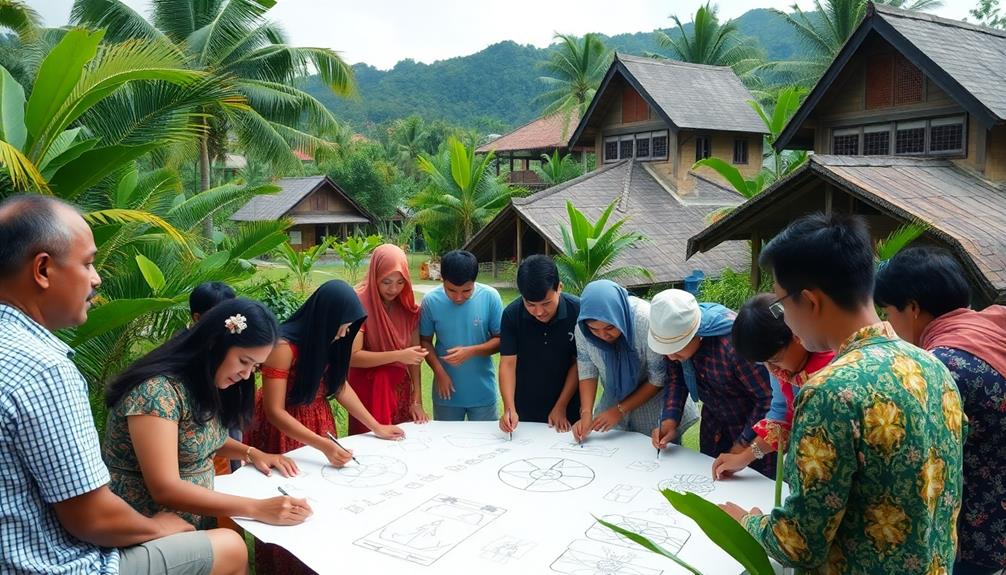
While rural communities in Indonesia face significant challenges from industrialization and urbanization, participatory design and co-creation offer a pathway to empower local residents. This approach emphasizes active involvement, treating community members as co-designers. It fosters social transformation and sustainability by engaging locals in decision-making processes, which is vital as these communities navigate the pressures of modern housing trends and the need for cultural preservation, as seen in the traditional and modern elements of Indonesian housing.
The participatory design process includes five key activities: initiation meetings, treasure mapping, idea generation, craft design workshops, and project reflection. These activities guarantee that everyone's voice is heard, allowing you to contribute to the outcomes that affect your life. Ethnographic methods document local perspectives and cultural activities, reflecting the unique needs and identities of your community.
Co-creation of knowledge enhances local narratives, empowering you and your neighbors to make collective decisions. By integrating Traditional Ecological Knowledge (TEK) into participatory design practices, you strengthen community empowerment and environmental stewardship.
This connection fosters a deeper understanding of sustainable practices that benefit both your community and the environment.
Role of Traditional Ecological Knowledge

Harnessing Traditional Ecological Knowledge (TEK) in Indonesia reveals the invaluable insights local communities possess about their environment and sustainable practices. TEK emphasizes local wisdom, like Niteni, which encourages observing natural phenomena to guide sustainable farming activities.
This approach mirrors the principles found in traditional Indonesian housing, where local materials and ecological awareness shape building practices. By applying the Pranatamangsa system, farmers align their agricultural practices with ecological cycles, enhancing their yields while ensuring sustainability.
Incorporating TEK into modern participatory design practices not only enriches community identity but also fosters pride, driving local engagement in sustainable development initiatives.
This approach promotes environmental stewardship by preserving traditional crop varieties and agricultural methods that are more resilient to climate change.
Community Engagement Strategies

Building on the foundation of Traditional Ecological Knowledge (TEK), community engagement strategies in Indonesia focus on involving local residents as active participants in the design process. This participatory approach encourages you to become a co-designer, fostering social innovation and sustainable development within your community.
For instance, incorporating elements of Indonesian Decorative Pillows can enhance living spaces while reflecting local culture and craftsmanship. In places like Sabrang Village, ethnographic methods help document local cultural practices, ensuring your perspectives and identities shape the design outcomes.
Collaborative workshops bring together local community members and external stakeholders—58 participants in total—to enhance engagement and ownership in development projects. By integrating TEK into these practices, you empower your community with local wisdom and sustainable agricultural methods that promote environmental stewardship.
Moreover, the co-creation of knowledge through participatory learning enriches local narratives, allowing you and your neighbors to collectively tackle challenges and support sustainable regional development.
Case Studies of Sustainable Practices
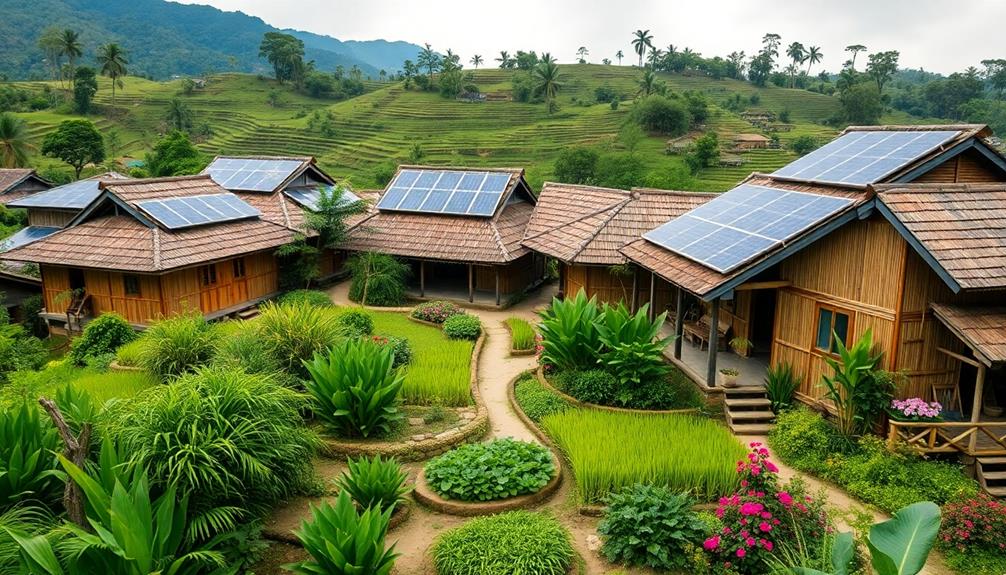
Sustainable practices in Indonesia showcase the transformative power of community-driven initiatives, especially in rural areas. Take Taba Padang village in southwest Sumatra, for example. Here, 470 households have embraced a village forest scheme, managing 1.5 hectares each in a protected forest. This approach promotes sustainable crop growth while preventing deforestation, allowing for the incorporation of local cultural elements into the farming practices, such as traditional planting techniques and community celebrations.
As a result, the community has seen increased incomes from cultivating coffee, pepper, durian, and rattan, which can be further enhanced through events that highlight their unique agricultural products Indonesian Party Decorations.
The introduction of motorbikes for harvest transportation has further improved farming operations, enhancing access to markets and making it easier for farmers to sell their products. Taba Padang's commitment to environmental conservation is evident in their shift from deforestation to reforestation. Regular inspections guarantee everyone adheres to sustainable practices, fostering a sense of responsibility within the community.
Recognized by the Indonesian Ministry of Environment and Forestry, Taba Padang's achievements highlight the potential for eco-tourism, thanks to its natural attractions like waterfalls and hot springs. This case study exemplifies how rural communities can thrive sustainably while protecting the environment, serving as a model for others looking to implement similar practices.
Frequently Asked Questions
What Are the Sustainability Plans of Indonesia?
Indonesia's sustainability plans focus on integrating smart village concepts and renewable energy projects. You'll see initiatives like the Emission Trading Scheme and carbon trading platforms aimed at enhancing community resilience and promoting environmental responsibility.
Why Are Rural Areas More Sustainable?
Imagine a thriving garden, where every plant shares its resources. In rural areas, community ties and traditional knowledge foster sustainability, allowing you to nurture the land and its diversity while ensuring a balanced, harmonious existence.
Conclusion
In Indonesia, the convergence of industrialization and a deep-rooted respect for traditional ecological knowledge creates a unique landscape for sustainable rural design. By embracing participatory design and community engagement, you're not just witnessing a trend; you're part of a transformative movement. Coincidentally, as rural areas adapt to modern challenges, they also revive age-old practices, illustrating that sustainability isn't merely a goal but a harmonious blend of past wisdom and present innovation, shaping a brighter future for all.
-

 Vetted5 months ago
Vetted5 months ago14 Best Personalized Father's Day Gifts for Your Husband – Show Him You Care
-

 Alfresco4 months ago
Alfresco4 months agoAlfresco Stacker Doors: Seamless Indoor-Outdoor Living!
-

 Vetted5 months ago
Vetted5 months ago15 Best EMS Foot Massagers for Neuropathy to Soothe Your Feet
-

 Craft and Textiles6 months ago
Craft and Textiles6 months ago15 Best Places to Buy Appliances for Your Home – Top Retailers Reviewed
-

 Craft and Textiles6 months ago
Craft and Textiles6 months ago15 Best Gifts for 4-Year-Old Girls That Will Spark Joy and Creativity
-

 Craft and Textiles6 months ago
Craft and Textiles6 months ago15 Best Battery-Powered Leaf Blowers for Effortless Yard Work
-

 Craft and Textiles6 months ago
Craft and Textiles6 months ago15 Best Cordless Mowers for Effortless Lawn Care – Top Picks of 2024
-

 Decorative Throws6 months ago
Decorative Throws6 months agoIs It Better to Dry Clean Blankets?










